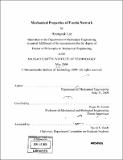| dc.contributor.advisor | Roger D. Kamm. | en_US |
| dc.contributor.author | Lee, Hyungsuk | en_US |
| dc.contributor.other | Massachusetts Institute of Technology. Dept. of Mechanical Engineering. | en_US |
| dc.date.accessioned | 2010-01-07T20:57:24Z | |
| dc.date.available | 2010-01-07T20:57:24Z | |
| dc.date.copyright | 2009 | en_US |
| dc.date.issued | 2009 | en_US |
| dc.identifier.uri | http://hdl.handle.net/1721.1/50588 | |
| dc.description | Thesis (Ph. D.)--Massachusetts Institute of Technology, Dept. of Mechanical Engineering, 2009. | en_US |
| dc.description | Includes bibliographical references. | en_US |
| dc.description.abstract | Cells sense, generate and respond to forces in their surroundings through cytoskeletal dynamics. Actin, the most abundant protein found in eukaryotic cells, is organized into various cytoskeletal structures that provide physical support for the cell and play important roles in numerous cellular processes. Assembly of F-actin into higher-order structures is regulated by over 100 actin binding proteins (ABPs). Although extensive measurements to estimate the mechanical properties of ABP/F-actin networks showed that they are nonlinear and viscoelastic, a full understanding of the origin of such fascinating behaviors is lacking. This thesis presents a multi-scale approach to identify the factors that determine the mechanical properties of F-actin networks from the macroscopic level to the single-molecule level. The mechanical properties of F-actin networks were probed by passive and active methods using optical tweezers. For the passive approach the thermal fluctuations of colloidal spheres are monitored to estimate the frequency-dependent complex shear modulus of an F-actin network. In the active approach, the response of an embedded microsphere to a driving force is tracked to obtain the strain-dependent viscoelasticity. The developed methods were applied to F-actin networks cross-linked with various ABPs such as filamin and a -actinin, with and without gelsolin to control filament length. Microstructures of those networks were also characterized in terms of filament length, mesh size, and degree of bundling. | en_US |
| dc.description.abstract | (cont.) Comparison between cross-linked F-actin with two different length scales of actin filament suggested that network connectivity is another critical parameter in determining mechanical properties. To better understand how the cross-linking protein responds to an external force, a single molecule assay was used to measure the rupture force of a complex formed by an ABP filamin linking two actin filaments. Both force-induced unbinding and unfolding of filamin were observed at the critical force of 70 ± 23pN and 57 ± 19pN, respectively, although unbinding occurred more frequently. Similar pulling experiments were also performed on cross-linked F-actin networks and an abrupt transition was observed in the force trace indicating network rupture. The critical forces at transitions exhibited a similar loading-rate dependence to that observed for rupture forces in the single molecule measurements. Nonlinear behavior observed in strain-dependent microrheology was found to be irreversible. Combined results of molecular unbinding, network rupture, and irreversible network properties suggest that unbinding rather than unfolding is a dominant mechanism governing the mechanical properties of cross-linked F-actin networks. In addition, the mechanical behavior of F-actin networks subjected to an external prestress was investigated using a shear device. Visualization of sheared F-actin networks showed the structural evolution including mesh deformation, filament alignment, and network rupture. | en_US |
| dc.description.abstract | (cont.) Measurement of mechanical properties as a function of external strain demonstrated that some regions exhibited strain-hardening while the others showed strain-softening. Aligned stretching of actin filaments observed at high strain seemed to play a role in strain-stiffening. By comparing the behaviors of an F-actin network cross-linked with wildtype and mutant FLNa, it was demonstrated how molecular structure of the ABP alters the mechanical behavior of F-actin network. | en_US |
| dc.description.statementofresponsibility | by Hyungsuk Lee. | en_US |
| dc.format.extent | 140 leaves | en_US |
| dc.language.iso | eng | en_US |
| dc.publisher | Massachusetts Institute of Technology | en_US |
| dc.rights | M.I.T. theses are protected by
copyright. They may be viewed from this source for any purpose, but
reproduction or distribution in any format is prohibited without written
permission. See provided URL for inquiries about permission. | en_US |
| dc.rights.uri | http://dspace.mit.edu/handle/1721.1/7582 | en_US |
| dc.subject | Mechanical Engineering. | en_US |
| dc.title | Mechanical properties of F-actin network | en_US |
| dc.type | Thesis | en_US |
| dc.description.degree | Ph.D. | en_US |
| dc.contributor.department | Massachusetts Institute of Technology. Department of Mechanical Engineering | |
| dc.identifier.oclc | 464614635 | en_US |
